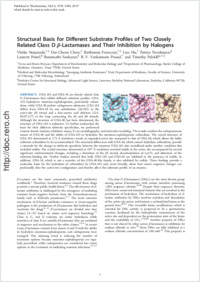Structural basis for different substrate profiles of two closely related class D β-lactamases and their inhibition by halogens
- Stojanoski, Vlatko Biochemistry Dpt, Baylor College of Medicine, Houston, United States - Pharmacology Dpt, Baylor College of Medicine, Houston, United States
- Chow, Dar-Chone Pharmacology Dpt, Baylor College of Medicine, Houston, United States
- Fryszczyn, Bartlomiej Biochemistry Dpt, Baylor College of Medicine, Houston, United States - Pharmacology Dpt, Baylor College of Medicine, Houston, United States
- Hu, Liya Biochemistry Dpt, Baylor College of Medicine, Houston, United States
- Nordmann, Patrice Molecular Microbiology Unit, Department of Medicine, University of Fribourg, Switzerland
- Poirel, Laurent Molecular Microbiology Unit, Department of Medicine, University of Fribourg, Switzerland
- Sankaran, Banumathi Berkeley Center for Structural Biology, Lawrence Berkeley National Laboratory, United States
- Prasad, B. V. Venkataram Biochemistry Dpt, Baylor College of Medicine, Houston, United States
- Palzkill, Timothy Biochemistry Dpt, Baylor College of Medicine, Houston, United States - Pharmacology Dpt, Baylor College of Medicine, Houston, United States
-
02.06.2015
Published in:
- Biochemistry. - 2015, vol. 54, no. 21, p. 3370–3380
English
OXA-163 and OXA-48 are closely related class D β-lactamases that exhibit different substrate profiles. OXA-163 hydrolyzes oxyimino-cephalosporins, particularly ceftazidime, while OXA-48 prefers carbapenem substrates. OXA-163 differs from OXA-48 by one substitution (S212D) in the active-site β5 strand and a four-amino acid deletion (214-RIEP-217) in the loop connecting the β5 and β6 strands. Although the structure of OXA-48 has been determined, the structure of OXA-163 is unknown. To further understand the basis for their different substrate specificities, we performed enzyme kinetic analysis, inhibition assays, X-ray crystallography, and molecular modeling. The results confirm the carbapenemase nature of OXA-48 and the ability of OXA-163 to hydrolyze the oxyimino-cephalosporin ceftazidime. The crystal structure of OXA-163 determined at 1.72 Å resolution reveals an expanded active site compared to that of OXA-48, which allows the bulky substrate ceftazidime to be accommodated. The structural differences with OXA-48, which cannot hydrolyze ceftazidime, provide a rationale for the change in substrate specificity between the enzymes. OXA-163 also crystallized under another condition that included iodide. The crystal structure determined at 2.87 Å resolution revealed iodide in the active site accompanied by several significant conformational changes, including a distortion of the β5 strand, decarboxylation of Lys73, and distortion of the substrate-binding site. Further studies showed that both OXA-163 and OXA-48 are inhibited in the presence of iodide. In addition, OXA-10, which is not a member of the OXA-48-like family, is also inhibited by iodide. These findings provide a molecular basis for the hydrolysis of ceftazidime by OXA-163 and, more broadly, show how minor sequence changes can profoundly alter the active-site configuration and thereby affect the substrate profile of an enzyme.
- Faculty
- Faculté des sciences et de médecine
- Department
- Médecine 3ème année
- Language
-
- English
- Classification
- Biological sciences
- License
- License undefined
- Identifiers
-
- RERO DOC 255898
- DOI 10.1021/acs.biochem.5b00298
- Persistent URL
- https://folia.unifr.ch/unifr/documents/304169
Statistics
Document views: 65
File downloads:
- nor_sbd.pdf: 169
